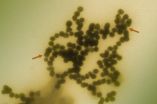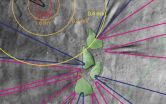(Press-News.org) The same properties that make engineered nanoparticles attractive for numerous applications—small as a virus, biologically and environmentally stabile, and water-soluble—also cause concern about their long-term impacts on environmental health and safety (EHS). One particular characteristic, the tendency for nanoparticles to clump together in solution, is of great interest because the size of these clusters may be key to whether or not they are toxic to human cells. Researchers at the National Institute of Standards and Technology (NIST) have demonstrated for the first time a method for producing nanoparticle clusters in a variety of controlled sizes that are stable over time so that their effects on cells can be studied properly.*
In their tests, the NIST team made samples of gold, silver, cerium oxide and positively-charged polystyrene nanoparticles and suspended them separately in cell culture medium, allowing clumping to occur in each. They stopped the clumping by adding a protein, bovine serum albumin (BSA), to the mixtures. The longer the nanoparticles were allowed to clump together, the larger the size of the resulting cluster. For example, a range of clustering times using 23 nanometer silver nanoparticles produced a distribution of masses between 43 and 1,400 nanometers in diameter. Similar size distributions for the other three nanoparticle types were produced using this method.
The researchers learned that using the same "freezing times"—the points at which BSA was added to halt the process—yielded consistent size distributions for all four nanoparticle types. Additionally, all of the BSA-controlled dispersions remained stable for 2-3 days, which is sufficient for many toxicity studies.
Having successfully shown that they could control the production of nanoparticle clumps of different sizes, the researchers wanted next to prove that their creations could be put to work. Different-sized silver nanoparticle clusters were mixed with horse blood in an attempt to study the impact of clumping size on red blood cell toxicity. The presence of hemoglobin, the iron-based molecule in red blood cells that carries oxygen, would tell researchers if the cells had been lysed (broken open) by silver ions released into the solution from the clusters. In turn, measuring the amount of hemoglobin in solution for each cluster size would define the level of toxicity—possibly related to the level of silver ion release—for that specific average size.
What the researchers found was that red blood cell destruction decreased as cluster size increased. They hypothesize that large nanoparticle clusters dissolve more slowly than small ones, and therefore, release fewer silver ions into solution.
In the future, the NIST team plans to further characterize the different cluster sizes achievable through their production method, and then use those clusters to study the impact on cytotoxicity of coatings (such as polymers) applied to the nanoparticles.
INFORMATION:
* J.M. Zook, R.I. MacCuspie, L.E. Locascio, M.D. Halter and J.T. Elliott. Stable nanoparticle aggregates/agglomerates of different sizes and the effect of their size on hemolytic cytotoxicity. Nanotoxicology, published online Dec. 13, 2010 (DOI: 10.3109/17435390.2010.536615).
NIST technique controls sizes of nanoparticle clusters for EHS studies
2011-02-03
ELSE PRESS RELEASES FROM THIS DATE:
Neurobiologists find that weak electrical fields in the brain help neurons fire together
2011-02-03
Pasadena, Calif.—The brain—awake and sleeping—is awash in electrical activity, and not just from the individual pings of single neurons communicating with each other. In fact, the brain is enveloped in countless overlapping electric fields, generated by the neural circuits of scores of communicating neurons. The fields were once thought to be an "epiphenomenon, a 'bug' of sorts, occurring during neural communication," says neuroscientist Costas Anastassiou, a postdoctoral scholar in biology at the California Institute of Technology (Caltech).
New work by Anastassiou ...
Field study of smoggy inversions to end
2011-02-03
SALT LAKE CITY, Feb. 2, 2011 – During the past two months, researchers launched weather balloons, drove instrument-laden cars and flew a glider to study winter inversions that often choke Salt Lake City in smog and trap dirty air in other urban basins worldwide.
The field campaign – part of a three-year study by the University of Utah and other institutions – ends Monday, Feb. 7 as atmospheric scientists begin analyzing data they collected to learn how weather conditions contribute to inversions, which occur when warmer air aloft holds cold air ...
Accountable care at Academic Medical Centers: Lessons learned
2011-02-03
Academic Medical Centers (AMCs) must adjust and adapt to the new health care reform laws or risk marginalization in the new health care arena, according to a New England Journal of Medicine Perspective article published online February 2.
The authors of the article, Scott A. Berkowitz, M.D., M.B.A., a fellow in cardiology and geriatrics at the Johns Hopkins University School of Medicine, and Edward D. Miller, M.D., dean and CEO of Johns Hopkins Medicine, argue that AMCs can not only remain relevant in the face of sweeping change, but can lead the way by serving as examples ...
Neiker-Tecnalia creates air-conditioned greenhouse with alternative energies
2011-02-03
Neiker-Tecnalia (The Basque Institute for Agricultural Research and Development) has created an air-conditioned greenhouse using alternative energies that enable the reduction of energy costs, improvements in energy efficiency and an increase in crop yields. The novel system has a biomass boiler and thermodynamic solar panels, which reach an optimum temperature for the crop without using fuels derived from petroleum oil or gas.
Neiker-Tecnalia has installed a biomass boiler (using wood and other organic waste as fuel), together with thermodynamic panels, with the goal ...
Older adults often excluded from clinical trials
2011-02-03
Older individuals, who constitute a rapidly growing population in the United States, account for a disproportionate share of health care utilization and cost.
Yet more than half of clinical trials exclude people based on their age or age-related conditions, according to a new study by Robert Wood Johnson Foundation (RWJF) Clinical Scholars® at the University of Michigan.
"These findings are concerning because it means that doctors cannot be confident that clinical trial results apply to their older patients," says Donna Zulman, M.D., the study's lead author and a ...
First new C. difficile drug in a generation superior to existing treatments: Researchers
2011-02-03
Clostridium difficile infection (CDI) is a significant and growing problem in hospitals and other health care facilities, but no new drugs to treat the condition have been developed in several decades. However, a large-scale, phase 3 trial conducted by Canadian and U.S. researchers shows that the new antibiotic Fidaxomicin is superior to existing treatments, demonstrating a 45 percent reduction in recurrences vs. the existing licensed treatment. Their results were published in February, 2011 in The New England Journal of Medicine.
"There wasn't much interest in C. difficile ...
First evidence for a spherical magnesium-32 nucleus
2011-02-03
Elements heavier than iron come into being only in powerful stellar explosions, supernovae. During nuclear reactions all kinds of short-lived atomic nuclei are formed, including more stable combinations – the so-called magic numbers – predicted by theory. Yet here, too, there are exceptions: the islands of inversion. Headed by physicists from the Excellence Cluster Universe at the Technische Universitaet Muenchen (TUM), an international team of scientists has now taken a closer look at the island that was first discovered. They have now published their results in Physical ...
New nanoparticles make blood clots visible
2011-02-03
For almost two decades, cardiologists have searched for ways to see dangerous blood clots before they cause heart attacks.
Now, researchers at Washington University School of Medicine in St. Louis report that they have designed nanoparticles that find clots and make them visible to a new kind of X-ray technology.
According to Gregory Lanza, MD, PhD, a Washington University cardiologist at Barnes-Jewish Hospital, these nanoparticles will take the guesswork out of deciding whether a person coming to the hospital with chest pain is actually having a heart attack.
"Every ...
UF astronomers, NASA team find 6 closely packed planets orbiting same star
2011-02-03
GAINESVILLE, Fla. — A NASA team including three University of Florida astronomers has found six new planets in a distant solar system that in some ways resembles our own.
The NASA team, including UF associate professor Eric Ford, postdoctoral associate Althea Moorhead and graduate student Robert Morehead, will announce its findings in Thursday's issue of the journal Nature.
"This is the new prototype for a system of rocky planets beyond our own," Ford said. "It changes our understanding of the frequency of solar systems like our own in deep space."
The planets orbit ...
All in the family: Lower back disease may be in your genes
2011-02-03
– Symptomatic lumbar disc disease, a condition caused by degeneration or herniation of the discs of the lower spine, may be inherited, according to a new study published in the Journal of Bone and Joint Surgery (JBJS).
"Previous studies, including studies of twin siblings and subsequent genetic marker studies, have suggested a genetic predisposition for the development of symptomatic lumbar disc disease but have been limited by a small number of patients," noted study author Alpesh A. Patel, MD FACS, assistant professor of orthopaedic surgery at the University of Utah ...




